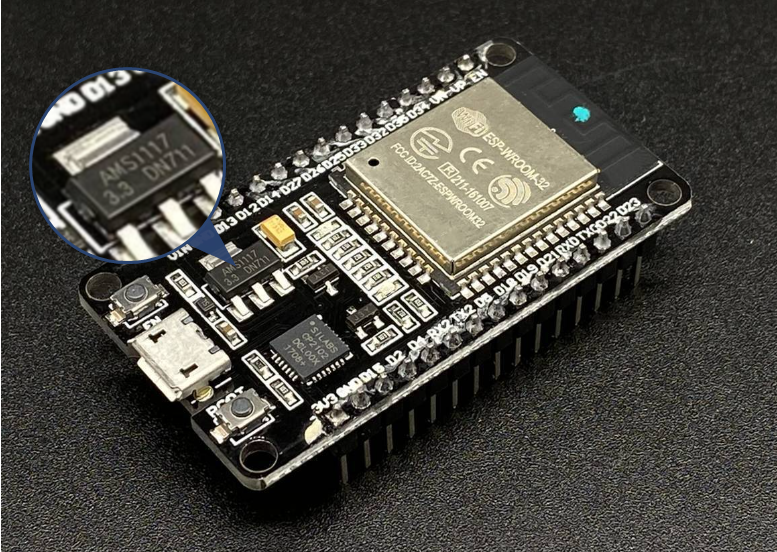Maximum Voltage ESP32 Can Take
The maximum working voltage of ESP32 is 3.3V. But this doesn’t mean that we cannot apply voltage greater than 3.3V to ESP32 board. ESP32 has an on -board voltage regulator which can take a maximum of 15V using the VIN and GND pin.
Once the voltage is input to ESP32 VIN pin this is then passed through the ESP32 onboard voltage regulator (AMS1117), which outputs constant 3.3V which is the working voltage of this board.
Note: Maximum working voltage of ESP32 is 3.3V. Maximum voltage that can be applied to ESP32 from its VIN pin is 15V.
Let’s discuss the ESP32 voltage regulator and how much voltage it can handle.
ESP32 Voltage Regulator
ESP32 microcontroller has a voltage regulator, which can regulate the input voltage from 5V-15V to a stable 3.3V supply voltage for its internal components. This voltage is then used to power the internal components of the ESP32, ensuring that they have a stable and consistent power supply.
The voltage regulator on the ESP32 is named as AMS1117 LDO regulator. AMS1117 is a series of voltage regulators that can output a maximum of up to 0.8mA-1mA of current. The voltage dropout against this regulator is very low.
This voltage regulator has a wide range of voltage ranges. AMS1117 is available in 6 different voltage output ranges containing fixed voltages, 1.2, 1.5, 1.8, 2.5, 3.3 and 5.0V. This regulator also has some variable and adjustable versions whose output can vary depending upon the sensitivity we set.

Here are AMS1117 key specifications:
| Specification | Value |
|---|---|
| Input voltage range | 1.2V to 11V |
| Output voltage | adjustable from 1.2V to 5.0V in 100 mV increments |
| Output current | up to 1A |
| Line regulation | ±1% |
| Load regulation | ±2% |
| Dropout voltage | 1.2V at 1A |
| Ripple rejection | 50 dB |
| Operating temperature range | -40°C to +85°C |
Benefits of Using a Onboard Voltage Regulator
Having a voltage regulator on the ESP32 is important for several reasons. Firstly, it helps to protect the internal components from damage caused by voltage fluctuations or power spikes. This is especially important in applications where the ESP32 is powered by a battery or a power supply that may not be regulated. Secondly, the voltage regulator helps to improve the overall performance and stability of the ESP32, as it ensures that the internal components have a consistent power supply.
In addition, the voltage regulator on the ESP32 is highly efficient with greater than 90% efficiency. This means that the power consumption of the voltage regulator is low, which helps to extend the battery life in applications where the ESP32 is powered by a battery.
Warnings
You should keep the following in mind when powering ESP32 with an external supply:
- Always provide ESP32 with regulated voltage supply
- Avoid connecting devices that draws more current like motors
- Avoid using multiple power sources at a time with ESP32
- If you see the voltage regulator is getting heat up, then turn off ESP32 board
Conclusion
The maximum voltage that the ESP32 can handle is 3.6V, and the maximum voltage that can be applied to ESP32 VIN pins is 15V. The voltage from the VIN pin is regulated using the AMS1117 regulator to 3.3V which equals ESP2 working voltage. It’s crucial to consider this parameter while designing an ESP32-based system. Overvoltage protection circuits should be incorporated to ensure that the voltage levels do not exceed the specified limit.
